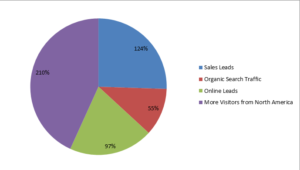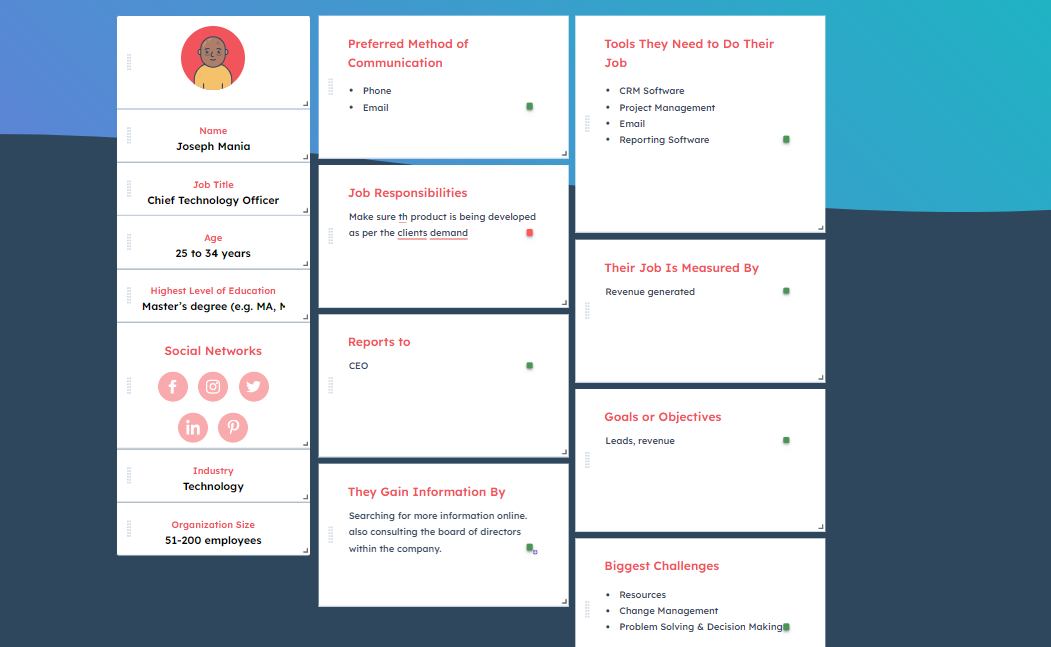Persona Analysis
Personas are in-depth descriptions of an existing or potential customer that stand in for a particular user group within a target market. Analysts and designers can create personas that depict a fully developed example of the intended audience for sales and marketing. They aid in the comprehensive visualization and comprehension of the diverse attitudes and actions of users within distinct demographic groupings by application designers.
At Digital Presence, we offer a comprehensive Persona analysis service covering all the aspects of your potential/existing customer with high accuracy. The report includes the Persona Overview, Pain Points, Key Motivators, Dos and Donts, How to Approach, Best Practices, and more.
The persona’s objective is to record the pertinent data required to portray the demography it represents. For example, a persona in product management describes the typical consumer for a particular product.As a result, product managers and other team members creating the product can better understand a specific type of user by using personas to identify essential characteristics, behaviors, goals, and wants.
Using a template that lists things like responsibility, difficulties, demographics, responsibilities, ambitions, likes, and dislikes, persona analysis allows you to create one-page profiles for these individuals.Painting a picture of your buyer, client, or user is the goal of persona analysis. It will help your teams understand who they are and what motivates them.

See a sample here
Package Starting from $399. Send an inquiry to know more
Why Do You Need Persona Analysis
By developing personas for your company, you can quickly and effectively summarize your target market, consumers, and users.
In addition, making personas can help you improve your comprehension of who your customers are and provide you with a precise record to use throughout the company to increase consumer awareness.
Personas are an excellent tool for ensuring everyone knows what your buyers, clients, and users desire and require. Moreover, they might be a quick and easy approach to acclimate new hires and serve as a refresher for everyone else when necessary.
The collaboration and improvement of understanding across the project team as to who the target client is and how we can support their objectives is one of the other long-term advantages of generating personas.
Using personas enables the team to concentrate on what the Sales Manager should do by more readily separating personal beliefs and prejudices.
You can significantly reduce the required development and redevelopment efforts and expenses by performing this process in the project’s development as soon as possible to avoid several design defects.
A company might develop a variety of identities, each serving a somewhat different function. Moreover, the personas could differ, even though they frequently use the same template and similar details for each identity.
Different Types of Personas
Product managers and marketing specialists frequently document different personas for their products. By doing this, businesses can better comprehend how to cater to the requirements of the various target audiences.
For instance, the product division of a business that sells goods directly to consumers may produce multiple iterations of its flagship product. As a result, it might have a more expensive, exclusive edition and a more reasonably priced, mass-market version.
The marketing and product teams must create distinctive profiles for the consumers using these product variations. The organization will be able to build the ideal product characteristics, packaging, pricing alternatives, and marketing messages for each consumer category by first understanding who these people are and their requirements, goals, and challenges.
In a business-to-business transaction, selling the company’s goods frequently involves multiple individuals from the client’s company. For example, it includes the product’s final consumer, a company executive or other judgment call, and the person in charge of making the purchase.
Let’s look at the most known personas:
Buyer personas are simulations of the customers who choose to buy your good or service. They are the most crucial persona for sales and marketing teams since creating effective messaging requires a thorough understanding of what motivates the customers you’re attempting to win over.
With buyer personas, you can discover how you can assist them and where your service or product fits in by concentrating on their day-to-day lives and places of employment. You should not include your product or service in your buyer persona. Instead, your full attention should be on that person. For instance, when describing the “likes” for a customer persona, you should consider what they “like” generally rather than what they “like” specifically about your product.
By developing buyer personas, you can better grasp your prospects’ priorities, obligations, objectives, difficulties, and pain points. This knowledge will enable you to focus your sales and marketing efforts, positioning your product, and customizing your messaging. You have the best chance of appealing to your prospects’ priorities and capturing their attention if you know what matters to them.
Analyzing buyer personas will also assist you in identifying efficient entry points for that market. Creating a persona will give you a list of ways to interact with that character and guide your marketing campaign planning, whether through their online behavior, the events they attend, or who influences them.
According to data from 2021:
- 82% of businesses that used buyer personas improved their value proposition.
- 71% of companies surpass lead generation and revenue targets with buyer profiles on paper.
- Ads that target specific behaviors are twice as effective as general ads.
User personas portray the people who utilize your product or service. These could be distinct from your buyer personas or not. Sometimes, especially in B2B organizations, the buyer is not the one who will use your product daily.
For instance, a CTO would purchase software that assisted developers in their coding, whereas developers are more likely to use it. As a result, a CTO would be your consumer persona, but you would also need to design a user persona for a programmer to understand their goals and objectives better.
You could more narrowly focus user personas on your specific good or service. For example, when using your product, you want to get the why and the how. Likewise, you can more narrowly focus the “likes” on what they like about your particular offering.
However, you shouldn’t limit your attention to how they use your goods. It’s crucial to acquire data that helps you understand their broader tasks, responsibilities, and issues to widen your solution, explore new chances, or see things you hadn’t initially anticipated.
Product teams frequently create user personas to aid in decision-making during product development. In addition, they help bring up awareness among the customers with members of the product owner and focus their efforts and thoughts on what would improve the lives of their users.
The principal persona for your product is the consumer persona. For a B2B product, it might be the user persona, while for a product geared toward consumers, it might be the user and buyer. A customer persona could stand in for either the user or the buyer personas for a company that sells goods to other companies.
The decision-maker is often a more specific persona – usually an executive at the company – in contrast to the buyer persona, representing various individuals in an organization who may participate in the decision-making process.
They focus mainly on the decision’s overall implications, such as if it will boost the business’s bottom line. Does it cost more than the company ought to invest? The product and messaging must come from the product and marketing teams selling to enterprises in a way that addresses the decision-maker persona’s worries.
Skytap, a self-service supplier of cloud automation solutions, had the following outcomes after using a customized content marketing approach with personas.

- 124% more sales leads
- 55% more organic search traffic
- 97% more online leads
- 210% more visitors from North America
What To Put Into Consideration While Building A Foundation For Your Persona
The goal is to have the personas merge with the project team. According to best practices, you should give them a common first name and use their position or title as their last name, as in Joseph Sales Manager. The team can find out who Joseph is relatively quickly.
Age, race, gender, and marital status are distinguishing traits that show the specific demographic the persona represents. It is also crucial to understand their employer, title, and remuneration, depending on the project.
A representative image is frequently employed to convey reality and provide designers with a solid anchoring point for the persona in their minds.
Information about the persona’s personality enhances realism and results in a more accurate portrayal of an actual user. It may include incentives, risks, and successes as motivators.
are the project-specific goals the persona is attempting to accomplish? There is always a case for selecting more than four goals.
Regarding your emphasis, the persona symbolizes particular skills. Some personalities may overlap or mix different job responsibilities.
The persona’s value can augment by the types of behaviors it exhibits and a statement explaining why it acts in a particular manner. Understanding frustrations and pain points are crucial.
The persona’s surroundings, namely the environmental circumstances, can significantly impact conduct.
Your personas can assist in directing choices for features and user interactions in the design of a product or app. For designers to view and be reminded of as they go about their daily tasks, personas can be printed and posted on the wall. It is an excellent way to assimilate the identities into the surroundings.
B2B and B2C Personas
There’s not much use in describing in great detail the pets of your Financial Director persona as if you’re a B2B organization, even if it’s a fantastic idea to flesh out all personas and give them life with additional information.
Similar to this, there is no use in meticulously explaining the difficulties your Business Leader persona could encounter when trying to get market data if you are B2C and, for example, selling golf products.
It is vital to gather the facts about your persona that will reflect how your product or service will help them enhance their life to understand them better.
Most of the time, whether you’re establishing a persona for B2C or B2B, you can use the same template; you will respond differently based on whether you’re concentrating on their professional life or home life.
Is There A Limit On The Number Of Personas?
Choosing the personas you require is the first step in constructing your personas. Next, you must go through your study and strive to narrow down your consumer kinds to a minimum, whether you’re creating buyer or user personas.
Remember that personas are generalized representations, so you don’t need a new persona for every problem with various consumer kinds.
Your teams will struggle to remember them and lose focus if you have many identities. The ultimate aim for marketers when it comes to buyer personas is unquestionably only to have one or two personas so you can genuinely focus and specialize and not spread your efforts and attention unevenly over various consumers. Although most firms have more than one or two personas, in reality, we advise attempting to keep the number as low as feasible.
Case Study: Developing Project On Client’s Intranet
First, we polled employees to categorize the various Intranet end-user groups. The poll focused on internet usage, goals, habits, and attitudes.
We then conducted in-depth one-on-one interviews with personnel from various departments and condensed the results into task contexts and personas.
We verified their integrity by giving the personalities to various organization stakeholders. Following their feedback, we tweaked and polished the identities.
Best Tips While Creating a Persona
Develop the user persona.
It would be best to create these profiles before beginning any product strategy. Ideally, you should complete them before writing the product's vision.Develop the user persona.
It would be best to create these profiles before beginning any product strategy. Ideally, you should complete them before writing the product’s vision.
Create A Profile Based On Actual People
Influential personalities aren't created based on conjecture. Real people who are the target market for your goods should be the subjects of your interviews. You might also try sending surveys to this group. The more concrete examples you can provide, the more beneficial the results will be.Create A Profile Based On Actual People
Influential personalities aren’t created based on conjecture. Real people who are the target market for your goods should be the subjects of your interviews. You might also try sending surveys to this group. The more concrete examples you can provide, the more beneficial the results will be.
Utilize Both Qualitative And Quantitative Research
To create your consumer profiles, strike the correct mix between combining aggregate data and anecdotal evidence. Then, when you draw on market research and the individual experiences of the people you speak with or survey, your personas will be as accurate as feasible.Utilize Both Qualitative And Quantitative Research
To create your consumer profiles, strike the correct mix between combining aggregate data and anecdotal evidence. Then, when you draw on market research and the individual experiences of the people you speak with or survey, your personas will be as accurate as feasible.
Example of Persona: Chief Technology Officer
An example is always helpful! Therefore, we have created the Chief Technology Officer persona. Remember that your Chief Technology Officer persona may alter slightly depending on your company or sector if you are establishing one.
Demographics will be our first topic. Here, we’ve given our officer the name, age, gender, and image of our persona. We’ve determined their level of education, familiarity with the company’s products, and influence inside their own business. The persona’s background briefly explains their origins and prior experiences.
Now that we have a closer look at their profile, let’s start with their interests. These are some of the things this persona enjoys:
- Trying out innovative, modern technology
- Having a good workplace
- Sharing victories with her team
- Amazing design

Dislikes:
- Being shocked
- Wasting her time
- Project or campaign delays
- Unwelcome sales calls
Reading and learning.
- Read leadership lite, marketing magic, and SEO pro blogs.
- Watches YouTube videos for The Marketing Manager’s Association
- Reads publications like “Marketer’s Monthly”
- Attends events like the “CMO Expo”
Finally, we’ve thought about the factors that shape this persona.
- Important industry bloggers
- Group of CMO colleagues and marketing authorities
- The thoughts and sentiments of her team
- Her superior, the CEO
Using our example as a guide, you can follow the easy steps to establish personas before developing your project. Our company is always willing to assist businesses in navigating this process if they are having trouble. Please don’t hesitate to contact us if you need innovative persona designs that will benefit your team. Please call us at……
